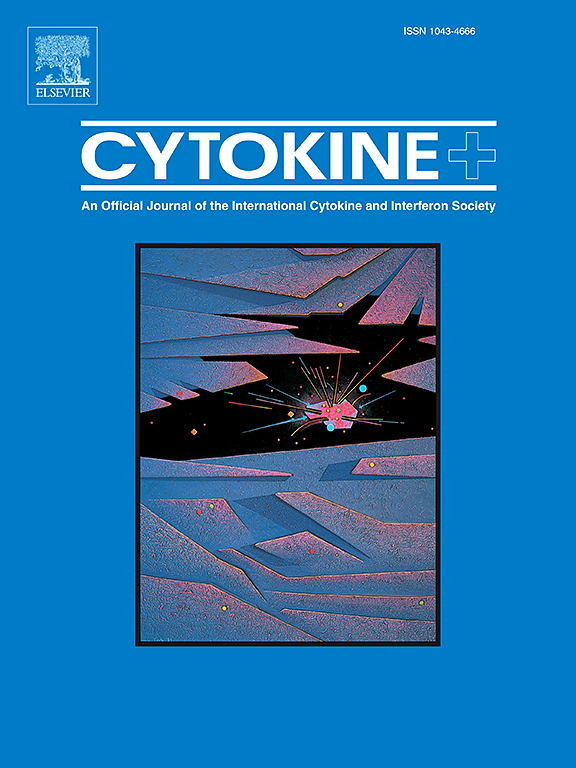TLR3作为一种新兴分子在类风湿关节炎中促进焦亡:一项结合生物信息学和实验验证的研究
IF 3.7
3区 医学
Q2 BIOCHEMISTRY & MOLECULAR BIOLOGY
引用次数: 0
摘要
背景:类风湿性关节炎(RA)是一种由免疫细胞介导的关节炎症性疾病。作为一种免疫相关的细胞死亡方式,焦亡在RA中的作用尚不完全清楚。本研究在RA中发现了新的热作用相关标志物,并证实了其在RA中的功能意义。方法:首先通过GEO数据库鉴定RA的关键热降解相关基因,并通过富集分析确定生物学途径。然后利用PPI网络、WGCNA和CIBERSORT分析筛选枢纽基因,评估免疫细胞浸润水平。最后通过验证实验确定hub基因在RA发病机制中的表达和调控作用,筛选潜在的治疗药物。结果:在RA中共鉴定出46个DEPRGs,参与nod样受体和toll样受体信号通路。进一步筛选发现,CCL5、LY96和TLR3 3个关键枢纽基因在RA滑膜组织和FLS中的表达显著升高,可能成为RA的诊断标志物。免疫浸润分析显示hub基因与浆细胞、T淋巴细胞和巨噬细胞相关。对关键中枢基因TLR3的进一步研究发现,敲低TLR3可显著抑制RA FLS的过度增殖和焦亡,地塞米松和阿霉素作为潜在药物可通过抑制TLR3治疗RA。结论:我们的研究表明,TLR3的高表达促进FLS焦亡和RA的进展,提示其作为RA的生物标志物和治疗靶点的潜力。本文章由计算机程序翻译,如有差异,请以英文原文为准。

TLR3 as an emerging molecule facilitating pyroptosis in the context of rheumatoid arthritis: A study combined bioinformatics and experimental validation
Background
Rheumatoid arthritis (RA) is an inflammatory disease of the joints mediated by immune cells. As an immune-related mode of cell death, pyroptosis has yet to be fully understood in RA. This research identified novel pyroptosis-related markers in RA and confirmed its functional significance in RA.
Methods
Initially, crucial pyroptosis-related genes of RA were identified through GEO database, and biological pathways were determined through enrichment analysis. Then, PPI network, WGCNA and CIBERSORT analysis was utilized to screen hub genes and evaluate immune cell infiltration levels. Finally, validation experiments determined hub genes expression and regulatory roles in RA pathogenesis, and screened potential therapeutic drugs.
Results
A total of 46 DEPRGs in RA were identified, which involved in NOD-like receptor and Toll-like receptor signaling pathway. Further screening revealed 3 crucial hub genes: CCL5, LY96, and TLR3 had significantly increased expression in RA synovial tissue and FLS, which might become diagnostic markers of RA. Analysis of immune infiltration revealed that hub genes exhibited associations with plasma cells, T lymphocytes, and macrophages. Further study on the crucial hub gene TLR3 revealed that knocking down TLR3 significantly inhibited the RA FLS hyperproliferation and pyroptosis, and dexamethasone and doxorubicin, as potential drugs, could treat RA by inhibiting TLR3.
Conclusion
Our study indicates that high expression of TLR3 promotes FLS pyroptosis and RA progression, suggesting its potential as both a biomarker and a therapeutic target for RA.
求助全文
通过发布文献求助,成功后即可免费获取论文全文。
去求助
来源期刊

Cytokine
医学-免疫学
CiteScore
7.60
自引率
2.60%
发文量
262
审稿时长
48 days
期刊介绍:
The journal Cytokine has an open access mirror journal Cytokine: X, sharing the same aims and scope, editorial team, submission system and rigorous peer review.
* Devoted exclusively to the study of the molecular biology, genetics, biochemistry, immunology, genome-wide association studies, pathobiology, diagnostic and clinical applications of all known interleukins, hematopoietic factors, growth factors, cytotoxins, interferons, new cytokines, and chemokines, Cytokine provides comprehensive coverage of cytokines and their mechanisms of actions, 12 times a year by publishing original high quality refereed scientific papers from prominent investigators in both the academic and industrial sectors.
We will publish 3 major types of manuscripts:
1) Original manuscripts describing research results.
2) Basic and clinical reviews describing cytokine actions and regulation.
3) Short commentaries/perspectives on recently published aspects of cytokines, pathogenesis and clinical results.
 求助内容:
求助内容: 应助结果提醒方式:
应助结果提醒方式:


